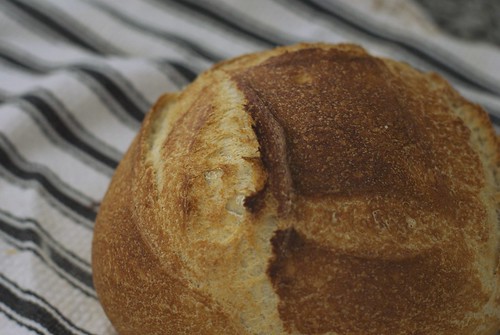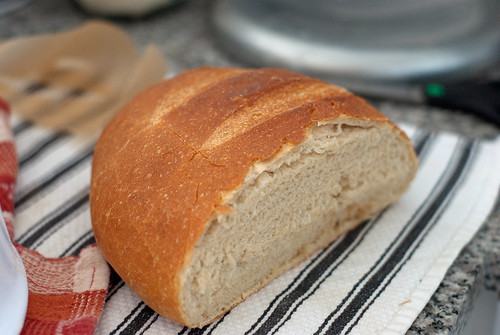
Pane Di Como recipe from The Italian Baker on seriouseats.com
Serious Eats has a short review of The Italian Baker up on their site, and a recipe for one of the breads, Pane Di Como.
http://www.seriouseats.com/recipes/2012/02/the-italian-bakers-pane-di-como-bread-recipe.html
I decided to try it out, and made the starter last night. I used some Barley malt syrup I had in my fridge, and given how "stringy" it gets when it's cold I had a very hard time getting a scant teaspoon. I didn't have much else to do so I ended up sitting in the kitchen watching the yeast + warm water + malt syrup in a bowl and was fascinated to watch the yeast start foaming up right before my eyes. Wow. Kind of neat to watch it go!
Then I added in the rest of the starter ingredients and went to bed. The directions had led me to believe that the starter would be very dry in the morning (about 9 hours later) but I found that under the surface it was still pretty wet. I went ahead and followed the directions to add more water and flour, then left it to rise for 2 hours. It might be because our apartment is a little cool in the mornings, but I saw almost no rising action until well over an hour into it, then it puffed up.
I'm afraid that there was probably a lot of de-gassing when I wrestled out of my ungreased bowl (ooops) and used a bread knife to cut it in half. Formed two round shapes and inverted a mixing bowl over each, then I walked away for an hour.
The directions say to heat the oven to 425, but I have a feeling that my cloche works better if you heat the oven to 500F with it inside for 30 minutes, then lower the temperature once the bread is inside. So that's what I did. The loaves baked 25 minutes with the cloche cover on, then barely another 10 with it off before the inside was 200F and I took it out.

It has a nice, light texture and seems great for sandwiches.

I did have problem shaping that perhaps someone can offer me some hints with. I shaped both loaves at the same time into round balls and left them resting. I can only bake one at a time in my cloche, so the other loaf had an extra ~40 minutes. I noticed it had started slumping sideways, so right before putting it in I tried doing another quick reshaping by pulling the sides down to beneath the loaf. Should I have held off on the initial shaping of that second loaf? Maybe put it in the fridge while the first one cooked?


I encountered exactly the same issue with the second of a pair of Tartine Country Boules today and damn if didn't try to I prop it back to attention while on the peel. Bad idea. Deflated and came out dense (I assume -- haven't sliced it yet, but it's much smaller than the first one). Delicate stuff.
The lesson I took away from that is that one should wait one oven cycle time period (~30 min) to shape and couche/banneton the second loaf of a two-loaf batch of dough if oven space is limiting. Extending the BF or bench rest after initial shaping by 30 min should have lesser consequences than executing a doomed 11th hour kludge on an over-proofed dough. That's an untested conclusion, but makes to me. But I'm open to others' strategies.
My father-in-law was a great chef born and trained in Bellagio on Lake Como. When anyone in the family is going down the lake to Como from Bellagio, the others always say "Bring back a loaf", since the bread in the town of Como is known to be better than anywhere else around the lake. That's reassuring to me every time my Tartines disappoint -- I just say to myself, "well, this isn't San Francisco, so it's not my fault." Helps a little.
THANKS for the link to the Como bread. Another one for the list.
tdb